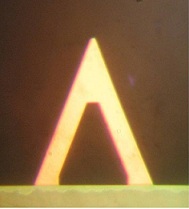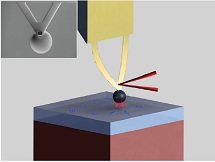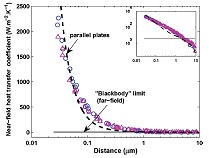Radiation Transport and Photon Management
The study of radiation transport is fundamentally built upon the study of electromagnetic waves and their interactions with materials and structures. In the context of radiative heat transfer, we are especially focused on understanding and controlling energy transport via electromagnetic radiation. In the NanoEngineering group, we aim to further the fundamental understanding of radiation transport at the nanoscale by studying radiative heat transfer across nanometer distances and the effects of nanostructuring in the optical properties of materials. The practical implications of our research can be felt in a variety of applications including more efficient photovoltaics, solar thermal systems and solar thermoelectric energy conversion, and optical characterization of materials' properties.
Although our current research consists of the aforementioned topics, in the past we have also conducted studies on selective surfaces, photonic crystals and metamaterials. For further information on these topics, please refer to the publications page.
High Sensitivity Thermal Measurement Platform
Probing radiative heat transfer at the nanoscale presents a significant challenge by virtue of the need to measure small fluctuations in heat flux (10-12-10-9 W) and temperature (10-2 K). To meet these requirements, we use an atomic force microscope (AFM) bimorph cantilever (see Figure 1) as a high sensitivity heat flux and temperature sensor. The operating principle of this sensor is based on the bimetallic bending effect. In essence, if a beam is composed of two layers of materials with dissimilar thermal expansion coefficients, the beam will bend when a temperature change is imposed. To measure this bending, an optical detection system similar to a conventional AFM head is used where a laser is reflected off the tip of the cantilever onto a position sensitive detector. By virtue of the dimensions of these cantilevers, it is possible to achieve a heat flux sensitivity of 10-12 W and a temperature sensitivity of 10-6 K.1
In principle, the use of a bimorph cantilever can be tailored to a wide variety of studies given its high sensitivity characteristics. For example, we have conducted thermal conductivity measurements on high thermal conductivity polyethylene nanofibers, as mentioned in the section on 'Phonon Transport.'2 In our studies on thermal radiation, we utilize these sensors by attaching samples at its tip which function either as a radiative emitter or absorber.
Near Field Radiation Transfer
The transport of energy by electromagnetic radiation generally consists of two types of modes: far field propagating electromagnetic modes and near field evanescent modes that quickly decay over submicron length scales. These near field modes could originate from the presence of surface phonon polaritons and surface plasmons which are hybrids of photons with phonons and electrons. In classical radiative heat transfer, far field modes are the primary carrier in energy transport and it is in this regime where Planck's blackbody limit is formulated. However, when two bodies are closely spaced such that they are within the decay length of these near field modes, it is possible for these modes to tunnel across. From theory it can be shown that the resulting enhancement in radiative transfer can break Planck's blackbody limit.
To measure near field radiation transfer, we initially considered a glass-glass configuration as shown in Figure 2. A glass sphere is attached to an AFM bimorph cantilever and a glass substrate is affixed to a piezoelectric translation stage. As the separation distance between the two materials decreases, the resulting enhancement in radiative transfer will result in a temperature decrease in the cantilever. This temperature change is measured via a correlated bending response from the cantilever. Therefore, upon calibrating the cantilever response, it is possible to extract quantitative data on the near field thermal conductance which can be used to directly compare with theory.
From Figure 3, we have definitively demonstrated from our experiments that near field radiation transfer can indeed exceed Planck's blackbody limit by nearly three orders of magnitude at a separation distance as small as 30 nm. Currently, we seek to push this separation distance even closer to further our understanding of near field radiation transfer.3-7
Optical Properties of Nanostructures
Individual nanostructures such as nanowires and nanoparticles are known to theoretically exhibit a strong enhancement in absorptance due to confinement of surface plasmon and phonon polariton modes. Mie theory, which consists of a set of analytical solutions to the Maxwell equations, can be used to predict the strength and frequency of these modes. However, the direct and quantitative measurement of the absorptance remains a significant challenge.
To accomplish this task, the heat absorbed by the nanostructure must be directly measured. An AFM bimorph cantilever is once again used by directly attaching a nanostructure to the cantilever thus functioning not only as an absorber but also as a thermal sensor. We are using this technique to characterize different nanostructures.
Our ultimate goal is to establish a measurement platform from which we can analyze and design new nanostructures for use in photonic applications.
References
- S. Shen, A. Narayanaswamy, S. Goh and G. Chen, Thermal conductance of bimaterial microcantilevers, Applied Physics Letters, Vol. 92, 063509, 2008.
- S. Shen, A. Henry, J. Tong, R. Zheng, and G. Chen, Polyethylene nanofibres with very high thermal conductivities, Nature Nanotechnology, Vol. 5, pp. 251-255, 2010.
- A. Narayanaswamy and G. Chen, Thermal near-field radiative transfer between two spheres, Physical Review B, Vol. 77, 075125, 2008.
- A. Narayanawamy, S. Shen, and G. Chen, Near-field Radiative Transfer Between a Sphere and a Substrate, Physical Review B, Vol. 78, 115303 (1-4), 2008
- L. Hu, A. Narayanaswamy, X. Chen, and G. Chen, Near-Field Thermal Radiation between Two Closely Spaced Glass Plates Exceeding Planck's Blackbody Radiation Law, Applied Physics Letters, Vol. 92, 133106 (1-3), April 1, 2008.
- S. Shen, A. Narayanaswamy, and G. Chen, Surface phonon polariton mediated energy transfer between nanoscale gaps, Nano Letters, Vol. 9, pp. 2909-2913, 2009.
- A. Narayanaswamy, S. Shen, L. Hu, X. Chen, and G. Chen, Breakdown of the Planck blackbody radiation law at nanoscale gaps, Applied Physics A, Vol. 96, pp. 357-362, 2009.


